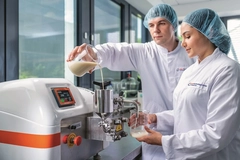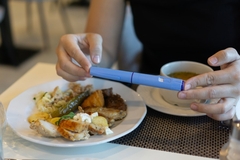The GLP-1 movement: How weight management medication is reshaping F&B
Key takeaways
- F&B brands are reformulating with high-protein, functional, and fortified products to meet the nutritional priorities of GLP-1 users.
- Manufacturers and quick-service restaurants are offering smaller, portion-controlled meals and snacks packed with nutrients.
- Foodservice operators are introducing lighter entrées, half-portions, and protein-centric dishes, alongside mocktails and functional beverages.
As GLP-1 medications gain momentum to support weight management, the food and beverage industry is heavily influenced by the rise of this crucial behavioral and nutritional shift. The popularity of GLP-1 medications is not just a pharmaceutical trend, but a growing influence on how people make decisions about food, what they purchase, and how they eat out.
We examine how GLP-1 medications, such as Ozempic, Mounjaro, and Wegovy, are reshaping the food and beverage landscape as industry leaders respond to this emerging trend.
Protein product innovation
GLP-1 users are realizing they need a different set of nutritional priorities, and packing in protein is vital.
Consumers are gravitating toward high-protein, fiber-rich, and functional foods that support energy and muscle retention. This shift is illustrated in Innova Market Insights’ top trend for 2026, “Powerhouse Protein,” which highlights how consumers are not just looking for protein-enhanced products, but wanting them to have at least another key nutritional benefit.
This new demand is prompting food innovators to develop protein-enhanced snacks, fortified beverages, and meal replacements that have multiple nutritional credentials.
High-protein snacks appeal to GLP-1 users who want smaller portions that still deliver satiety and muscle support.
Some recent examples of NPD on the market include high-protein yogurts, such as Chobani’s Complete yogurt drink, which contains 15–30 g of complete protein to help people feel fuller for longer, and vitamin B12 for natural energy.
The Greek yogurt giant recently announced plans to build a US$1.2 billion production facility in New York, US, to support its growth plans. This significant investment signals the company’s intention to produce more than one billion pounds of yogurt and other dairy products annually.
In the summer of 2025, Danone launched its Oikos Pro yogurt drinks, specifically targeting GLP-1 users. The yogurt drink is made with the patented Advanced Fusion Blend, contains 23 g of complete protein, 5 g of prebiotic fiber, and key vitamins like D, B3, and B12, in a compact, lactose-free, 0 g added-sugar drink. It’s available in Strawberry, Mixed Berry, and Vanilla flavors.
Oikos partnered with nutrition scientists and dietitians to create Oikos Fusion, said Rafael Acevedo, president of Yogurt at Danone North America, at the time of the launch in August.
“Pairing Danone’s decades of science expertise with the Oikos brand’s emphasis on strength and high-quality protein enabled us to create something truly unique for people looking to maintain muscle mass while on a weight loss journey.”
“The growing need for tailored nutrition solutions for people experiencing muscle mass loss is something we can expertly tackle. We know change takes strength, and we believe weight loss isn’t only about taking things away — it’s about adding and strengthening routines with nutrient-dense products that help people better meet their goals.” GLP-1 medications are reshaping F&B, driving demand for high-protein, functional foods.
GLP-1 medications are reshaping F&B, driving demand for high-protein, functional foods.
Smaller portion sizes
People who are managing their weight may place a sharper focus on portion control and nutrient balance in their eating choices. It’s key for GLP-1 users to stay full for extended periods, leading to an increase in healthy snacking occasions.
Brands are experimenting with smaller portions, snack-sized meals, and portion-controlled packaging. For food manufacturers and restaurants, the focus is now on delivering flavor, texture, and nutrition in fewer bites.
Some packaged food examples include Lean Cuisine Balance Bowls, which are smaller, calorie-controlled bowls (250–300 calories). The focus is on protein and fiber. Evol “Mini Meals” are downsized frozen meals designed for portion control, maintaining flavor but with smaller serving sizes.
Nestlé introduced Vital Pursuit, specifically marketed toward GLP-1 weight loss medication users, last year. The products are high in protein, a good source of fiber, and contain essential nutrients, and they are portioned to align with a weight loss medication user’s appetite.
At the time of the launch, the Swiss F&B giant deliberately positioned Vital Pursuit as the first food brand from Nestlé intended for GLP-1 users, complementing the eating habits of millions who are currently prescribed a weight loss medication or actively working to manage their weight.
“As the use of medications to support weight loss continues to rise, we see an opportunity to serve those consumers. Vital Pursuit provides accessible, great-tasting food options that support the needs of consumers in this emerging category,” said Steve Presley, CEO of Nestlé North America.
“We’re leveraging our deep understanding of consumers and nutritional science to stay ahead of the trends shaping consumer behaviors, and innovating across our portfolio to deliver products.”  From protein-packed snacks to portion-controlled meals, F&B brands are innovating to meet GLP-1 user demands.
From protein-packed snacks to portion-controlled meals, F&B brands are innovating to meet GLP-1 user demands.
What’s on the menu for GLP-1 users?
There is a rise in restaurants offering menus with smaller portions, lighter entrées, and balanced nutrition options to accommodate changing dining habits. Some offer half portions, or deliberately target protein-focused dishes, and promote no-alcohol drinks like mocktails.
The foodservice and restaurant sector’s response to GLP-1 users is, so far, subtle. It’s not common to see explicit marketing on menus, but there are examples of how menu strategies across the foodservice industry are reflecting the needs of a GLP-1 diner.
For instance, “flex portions” cater to smaller appetites without sacrificing experience or quality, while add-on protein options, such as eggs, legumes, and Greek yogurt sides, are becoming increasingly popular. Many quick-service restaurants also offer functional add-ons, such as chia, flaxseed, or adaptogenic ingredients, in their smoothies and bowls.
Looking ahead
The uptake of GLP-1 medication as a mainstream weight management tool is having an undeniable impact on industry innovation and actively changing the food economy. As these medications become more widespread, the surge in protein-enhanced products targeting muscle support, with more than one functional benefit beyond high protein, is expected to spike even further.
GLP-1 drugs are also influencing marketing strategies and menu development, as the foodservice sector begins to incorporate the GLP-1 angle into its offerings.
Expect a surge in protein-forward snacks, fortified beverages, and nutrient-dense meal replacements that align with the evolving nutritional priorities of GLP-1 users.



















